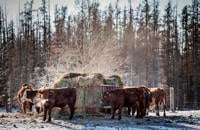Former American president and current Republican nominee Donald Trump was asked earlier this month by a news reporter what he would do to help alleviate California's natural disasters and other water woes. Trump responded saying that there was a "large faucet" in Canada, and if turned, it could divert water that's "aimlessly" being poured into the Pacific from the north to California. This is false. Two şĂÉ«tvs who are experts on water systems, infrastructure and engineering say no such "large faucet" exists in Canada and there is no infrastructure that can divert şĂÉ«tv water directly to Los Angeles.
Donald Trump was how he would help alleviate California's wildfires and help "the people across the country whose homes are jeopardized by natural disasters."
Trump suggested to a news conference at his Los Angeles golf club in California's coastal city of Rancho Palos Verdes that the dry state's neighbour in the north can turn a "large faucet" to bring more water into California to help the state solve its problems.
“You have millions of gallons of water pouring down from the north with the snow caps in Canada and all pouring down and they have essentially a very large faucet," he said.
"You turn the faucet and it takes one day to turn it. It's massive, it's as big as the wall of that building … and you turn that and all of that water goes … aimlessly into the Pacific and if they turned it back, all of that water would come right down here and right into Los Angeles."
Rating: False
Several parts of the world are increasingly experiencing extreme weather events and the Western U.S. state of California is no exception.
Over the years, California has experienced record-breaking wildfire seasons, prolonged droughts followed by floods that have affected agriculture, water shortages, and more recently landslides along its Pacific coast after intense rainfall.
During his news conference, Trump promised the people of California that if they vote for him in the coming U.S. election in November, they will "have more water than you ever saw."
Alain Pietroniro, a professor of civil engineering with the Schulich School of Engineering at the University of Calgary who has spent about three decades studying water resource engineering, says this is not the first time Trump has suggested water diversion to help dampen California's extreme climate problems and other water woes.
Trump recently suggested California bring in water to dampen its dry land so the blazes don't erupt or spread.
"He seems to be referring to a few issues," Pietroniro said.
He and another şĂÉ«tv expert said systems that divert water back and forth between the United States and Canada exist, but there is no infrastructure, let alone a water system with "a large faucet," that would directly transport water from şĂÉ«tv snowcaps to California to help ease its problems.
"There's no giant faucets here," Pietroniro said in a phone interview from Canada.
"I don't really understand what he's saying."
Bryan Karney, a professor with University of Toronto's department of civil and mineral engineering, agrees "a faucet obviously doesn't exist."
Trump's office did not respond to a request for clarity on what faucet he was referring to.
Global Affairs Canada said in an email to şĂÉ«tvthat it "cannot interpret" what Trump may have meant and would need more details to comment further.
Existing diversions
Karney said the idea of building infrastructure that would divert şĂÉ«tv water to the United States to help certain states deal with severe water shortages or various natural disasters such as droughts is not new.
Karney said, for example, a plan created by an American engineering firm called the grabbed the attention of Congress in the 1960s as it explored the idea of diverting water from high precipitation areas to help drier areas in Canada, the United States and Mexico.
"But because of the delicacy of those negotiations and because of the deep pockets that are required to do that, I don't think anyone takes it particularly seriously at the moment," he said.
He said these types of water diversion ideas are "multitrillion dollar projects that would require a gigantic amount of co-ordination and negotiation."
Pietroniro added Trump might be confusing the pathways of existing rivers that flow between Canada and the United States.
He said one of them is the Columbia River but it doesn't reach Los Angeles.
The International Joint Commission, an American and şĂÉ«tv government group that oversees the river together with the help of a treaty, "The Columbia River runs through British Columbia down into the states of Washington and Oregon, but its watershed spreads even beyond that into the boundary states of Idaho and Montana."
Pietroniro said building infrastructure that would divert the water from that river to Los Angeles would cost "a lot of money" and could have "everlasting impacts on the ecosystem."
"Technically, it's feasible. It'd be expensive. I can't see any kind of consensus on that."
He said California might have to find solutions to its water problems within the borders of its state to help its farmers dealing with prolonged droughts and other climate-related issues.
Sources
The full news conference with Donald Trump's remarks can be found on CNBC-TV18's YouTube channel () and a clip of his comments about the faucet is archived
()
International Joint Commission's description of the track of Columbia River diversion can be found ()
About şĂÉ«tv Press fact checks
You can find out more about şĂÉ«tvhere and about şĂÉ«tv Press Fact Checks here. To reach our fact-checking team with any tips, corrections or comments, please email us at cpfactcheck@thecanadianpress.com.
Note to readers: This story was updated on Oct. 1, 2024, to specify that Alain Pietroniro is a professor at Schulich School of Engineering, part of the University of Calgary.







































